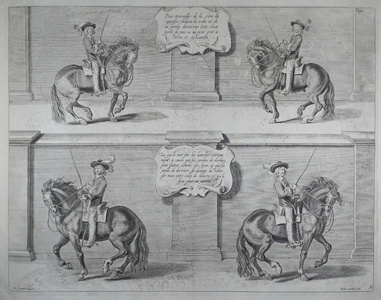| Method | Copper engraving |
| Artist | Theodorus van Kessel after Abraham van Diepenbeeck |
| Published | 1658 - 1743 |
| Dimensions | Image: 380 x 500 mm, Plate 390 x 520 mm, Sheet 470 x 590 mm |
| Notes |
Plate 36 from "A General System of Horsemanship in All Its Branches," (La Methode et Invention nouvelle de Dresser les Chevaux). William Cavendish Duke of Newcastle's work on equestrian training and dressage, one of the finest seventeenth century illustrated books of horses. William Cavendish Duke of Newcastle (1592 – 1676) an affluent politician, soldier and royalist, fought for Charles I during the English Civil War. He established a riding school in Antwerp with several Barbary horses obtained in Paris, and in 1657, published his influential work on equestrian training techniques, "A General System of Horsemanship in All Its Branches", "La Methode et Invention nouvelle de Dresser les Chevaux". This work contained beautiful illustrations of Cavendish training and skilfully riding his horses at his Antwerp ménage and his various English estates like Welbeck Abbey and Bolsover Castle. Theodorus van Kessel (1620 - c.1660) was a prolific Dutch engraver working in Antwerp, predominantly reproducing works after Old Masters and best known for his engravings of work by Rubens, Van Dyke and Jan van den Hecke I. Abraham van Diepenbeeck (1596 - 1675) was a Flemish painter, glass-painter and designer of prints and tapestries. He was a pupil and assistant of Peter Paul Rubens. He worked in 's-Hertogenbosch, Antwerp, and in the early 1630s in Paris. Condition: Centre fold as issued. Small worm holes on lower central margin. Minor tears to upper and bottom edges, not affecting image. |
| Framing | mounted |
| Price | £350.00 |
| Stock ID | 41498 |

